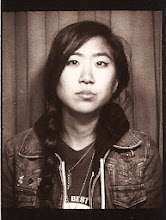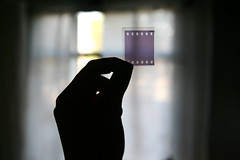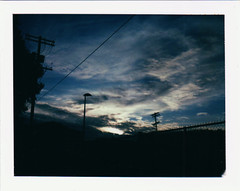One of my childhood dreams was to write books and illustrate them. I saw this as the ultimate form of storytelling - imagining the story in two forms they come in and having authorship over both. The classic bossy-child's dream.
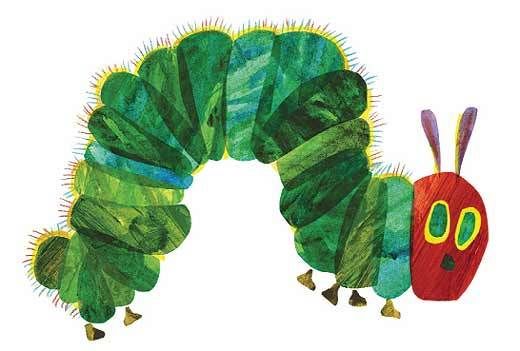
Eric Carle, of course with
The Very Hungry Caterpillar introduced me to simple yet intricate swatches of color arranged on a page to create vast landscapes from the point of view of a caterpillar, a large array of food the eponymous caterpillar proceeds to eat through, and the process of metamorphosis the caterpillar undergoes as he spins himself a cocoon to eventually emerge as a beautiful butterfly. Eric Carle's art also tuned me into my expressing my love of nature. I loved that I could read an Eric Carle book and gain knowledge of something previously unknown to me while at the same time enjoying his marvelous artwork. I remember as a youngster being excited whenever the newest Eric Carle book came out, because then my mom would go buy it for my sister and me, and we'd all read it together. For me he was the definition of a genius. He's illustrated (and written many of) over seventy books, of which the following are my perennial favorites:
Pancakes, Pancakes!, The Tiny Seed, The Grouchy Ladybug, The Very Busy Spider, A House For Hermit Crab, The Very Quiet Cricket, and Dragons Dragons.
I instantly took a liking to Bill Peet's stories and art for his free tone of voice (not that I thought that as a 6 year old, but I felt like he'd be like the cool uncle who talks to you like a friend rather than as a high-and-mighty adult, get it?) and his casual, whippy form of illustration that looks haphazard but is really just unrestrained and so expressive. I can say that the first autobiography I ever read was Bill Peet's, in which he talked about his experiences working as an animator for Disney, and from this is where I learned of the nature of another genius - Walt Disney. So from the words of Bill I learned that people have different sides to their personalities and must be able to control their emotions. I won't explain that, just read his autobiography. This book also got me fascinated with the self-story which made me go borrow a bunch of other autobiographies of other famous people. I was just disappointed that no one else (that I knew of) went and did an illustrated autobiography the way Bill Peet did. Bill also loved animals, as many of his works feature furry or feathered friends as he explores their personalities, giving them human-like qualities that allow one to empathize with them. It blew me away how in
The Whingdingdilly, he kept the dog Scamp's eyes consistent throughout - from his dissatisfied beginning as an ordinary brown dog to the fantastically different whingdingdilly. He gave his characters a soul, which always and still fascinates me. Some of my other Bill Peet favorites:
The Wump World, Buford The Little Bighorn, Cowardly Clyde, Chester The Worldly Pig, and Farewell To Shady Glade.
Quentin Blake is another big one. He, hand in hand with Roald Dahl really influenced my appreciation of verisimilitude-riddled and slightly twisted fantastical stories. Who else could masterfully depict Matilda's innocent yet brightly witty look as well as Quentin? And I can't forget the horror I felt when first viewing his Mr. and Mrs. Twit. Honestly I didn't think that much of his art, with their very scribbly, fast scrawling nature, but I liked that all his lines were clean and in a way extremely precise. So I basically fell in love with the spontaneity of his work and privately thought to myself that, like Quentin I don't have to do a perfect drawing of everything I attempt. I owe it to Quentin for having me realize that I can free up and let some messiness make the picture beautiful rather than take away from it. Although this messiness should not be confused with carelessness but rather with spontaneity. Some Roald Dahl/Quentin Blake collabos/masterpieces:
Esio Trot, The Magic Finger, The BFG, The Twits, Matilda, Charlie And The Chocolate Factory, The Witches.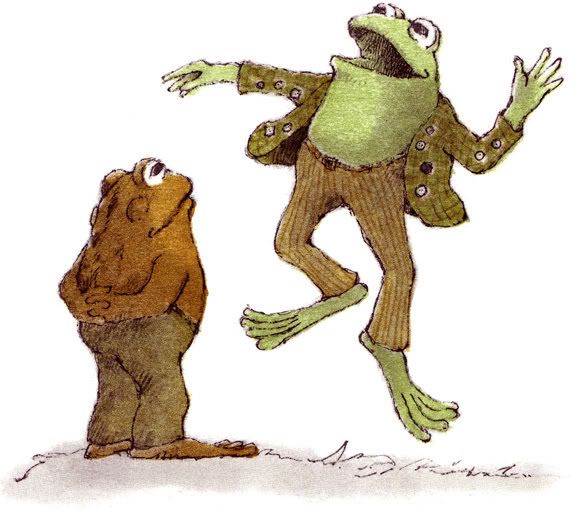
Arnold Lobel's
Frog and Toad series, still one of my favorite set of tales of all time, introduced to me the limited color palette. If I remember correctly Arnold used mostly greys, greens and browns and relied a lot on textures to illustrate his ideas. So simple yet effective. The dusty quality of his drawings, and his simple style of writing made me think Frog and Toad was an old, old story that I was lucky to stumble across before it got swept up and lost in the deluge of new, brighter-looking children's books. Silly kid thoughts. But the characters Frog and Toad strengthened my stronger-growing love of amphibians, which started when I was seven and inspired me to refine my frog-drawing techniques. Then when I started putting clothes on my frogs I referred back to Frog and Toad's distinguished clothing, before developing my own style. Apart from his distinctive illustrating style he had a funny way of writing, where I knew each time I read one of his books I knew it was an Arnold Lobel original. Quirky details like "tearwater tea" (Owl At Home) and explorations of character (exercising willpower in Frog and Toad Are Friends) made his books definite growing and learning experiences for me. Arnold Lobel books everyone should read:
Frog and Toad Are Friends, Frog and Toad Together, Frog and Toad All Year, Owl At Home, Mouse Soup, and Days With Frog and Toad.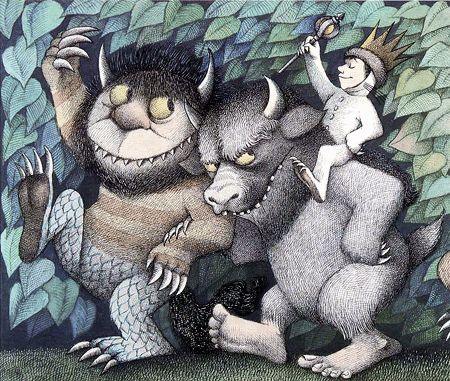
For the record Maurice Sendak's
Where The Wild Things Are failed to frighten me in the way silly parents and adults thought it did of young children. What bothered me more than the scary monsters was really just Max, the mischievous protagonist, with his pointed face, wild eyes, wolf suit and crazy antics. But as he traveled into the land of the Wild Things my slight unease turned to excitement. And that was that. The basis of my sister's and my imaginary games usually consisted of a faraway journey, sometimes precarious and lengthy but always concluded in time for dinner. And I believe this book tuned me into the idea of a long span of time occurring in the span of a relatively short one. So it got me thinking about space and time, too. Of Maurice Sendak I can only really recommend
Where The Wild Things Are and the
Little Bear books.

Shel Silverstein was a constant in my childhood. He's another one of those figures who just embodied freedom in terms of his poetry and prose and his drawings. He was always this mysterious figure to me, whose poems usually amused or frightened me, but more or less taught me little things about life. Like, do things yourself instead of slaving your younger sibling to do it for you, etc. And of course
The Giving Tree is one of the most powerful books I ever read about unconditional love. A fact I know about Shel Silverstein is how particular he was about his work being published. For example, he wouldn't let his poems or prose be published unless he had the exact say of what font type and size and feel of the paper they'd be printed on. He took this part of the publishing process very seriously, which is why (have you noticed?) that none of his books have ever been published in paperback. In this way he was a true artist, absolutely amazing. I recommend:
The Giving Tree, A Giraffe and A Half, The Missing Piece, A Light In The Attic, Where The Sidewalk Ends, Falling Up.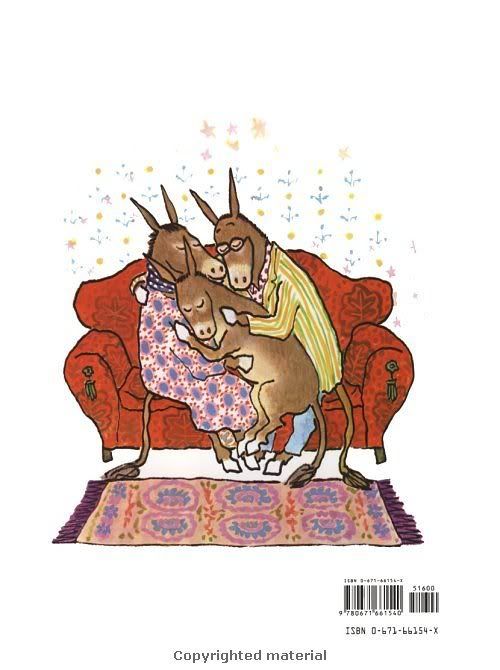
From William Steig's gem-toned illustrations to his amazing tales that explored the power of human relationships and characteristics in anthropomorphic animals I learned to transition from the picture book to the novel. One detail I recall noting is when in
The Amazing Bone Steig wrote that the bone lay in a patch of violets. And from that distance the flowers really did look like violets and not just haphazardly painted flowers. He paid so much attention to his own work and didn't undermine it in any way. His characters oftentimes go on great journeys and learn things about themselves in some way, or else just embark on great adventures. Having to read
Abel's Island in fifth grade I learned literary devices such as the simile, metaphor, onomatopoeia, and alliteration. And from this book I also learned to analyze situations a character finds himself in. Pretty amazing things to find in a children's novel. And did you know William Steig wrote Shrek? More notables:
CDB!, Silvester and the Magic Pebble, Amos and Boris, Doctor De Soto.
 Eric Carle, of course with The Very Hungry Caterpillar introduced me to simple yet intricate swatches of color arranged on a page to create vast landscapes from the point of view of a caterpillar, a large array of food the eponymous caterpillar proceeds to eat through, and the process of metamorphosis the caterpillar undergoes as he spins himself a cocoon to eventually emerge as a beautiful butterfly. Eric Carle's art also tuned me into my expressing my love of nature. I loved that I could read an Eric Carle book and gain knowledge of something previously unknown to me while at the same time enjoying his marvelous artwork. I remember as a youngster being excited whenever the newest Eric Carle book came out, because then my mom would go buy it for my sister and me, and we'd all read it together. For me he was the definition of a genius. He's illustrated (and written many of) over seventy books, of which the following are my perennial favorites: Pancakes, Pancakes!, The Tiny Seed, The Grouchy Ladybug, The Very Busy Spider, A House For Hermit Crab, The Very Quiet Cricket, and Dragons Dragons.
Eric Carle, of course with The Very Hungry Caterpillar introduced me to simple yet intricate swatches of color arranged on a page to create vast landscapes from the point of view of a caterpillar, a large array of food the eponymous caterpillar proceeds to eat through, and the process of metamorphosis the caterpillar undergoes as he spins himself a cocoon to eventually emerge as a beautiful butterfly. Eric Carle's art also tuned me into my expressing my love of nature. I loved that I could read an Eric Carle book and gain knowledge of something previously unknown to me while at the same time enjoying his marvelous artwork. I remember as a youngster being excited whenever the newest Eric Carle book came out, because then my mom would go buy it for my sister and me, and we'd all read it together. For me he was the definition of a genius. He's illustrated (and written many of) over seventy books, of which the following are my perennial favorites: Pancakes, Pancakes!, The Tiny Seed, The Grouchy Ladybug, The Very Busy Spider, A House For Hermit Crab, The Very Quiet Cricket, and Dragons Dragons. I instantly took a liking to Bill Peet's stories and art for his free tone of voice (not that I thought that as a 6 year old, but I felt like he'd be like the cool uncle who talks to you like a friend rather than as a high-and-mighty adult, get it?) and his casual, whippy form of illustration that looks haphazard but is really just unrestrained and so expressive. I can say that the first autobiography I ever read was Bill Peet's, in which he talked about his experiences working as an animator for Disney, and from this is where I learned of the nature of another genius - Walt Disney. So from the words of Bill I learned that people have different sides to their personalities and must be able to control their emotions. I won't explain that, just read his autobiography. This book also got me fascinated with the self-story which made me go borrow a bunch of other autobiographies of other famous people. I was just disappointed that no one else (that I knew of) went and did an illustrated autobiography the way Bill Peet did. Bill also loved animals, as many of his works feature furry or feathered friends as he explores their personalities, giving them human-like qualities that allow one to empathize with them. It blew me away how in The Whingdingdilly, he kept the dog Scamp's eyes consistent throughout - from his dissatisfied beginning as an ordinary brown dog to the fantastically different whingdingdilly. He gave his characters a soul, which always and still fascinates me. Some of my other Bill Peet favorites: The Wump World, Buford The Little Bighorn, Cowardly Clyde, Chester The Worldly Pig, and Farewell To Shady Glade.
I instantly took a liking to Bill Peet's stories and art for his free tone of voice (not that I thought that as a 6 year old, but I felt like he'd be like the cool uncle who talks to you like a friend rather than as a high-and-mighty adult, get it?) and his casual, whippy form of illustration that looks haphazard but is really just unrestrained and so expressive. I can say that the first autobiography I ever read was Bill Peet's, in which he talked about his experiences working as an animator for Disney, and from this is where I learned of the nature of another genius - Walt Disney. So from the words of Bill I learned that people have different sides to their personalities and must be able to control their emotions. I won't explain that, just read his autobiography. This book also got me fascinated with the self-story which made me go borrow a bunch of other autobiographies of other famous people. I was just disappointed that no one else (that I knew of) went and did an illustrated autobiography the way Bill Peet did. Bill also loved animals, as many of his works feature furry or feathered friends as he explores their personalities, giving them human-like qualities that allow one to empathize with them. It blew me away how in The Whingdingdilly, he kept the dog Scamp's eyes consistent throughout - from his dissatisfied beginning as an ordinary brown dog to the fantastically different whingdingdilly. He gave his characters a soul, which always and still fascinates me. Some of my other Bill Peet favorites: The Wump World, Buford The Little Bighorn, Cowardly Clyde, Chester The Worldly Pig, and Farewell To Shady Glade. Quentin Blake is another big one. He, hand in hand with Roald Dahl really influenced my appreciation of verisimilitude-riddled and slightly twisted fantastical stories. Who else could masterfully depict Matilda's innocent yet brightly witty look as well as Quentin? And I can't forget the horror I felt when first viewing his Mr. and Mrs. Twit. Honestly I didn't think that much of his art, with their very scribbly, fast scrawling nature, but I liked that all his lines were clean and in a way extremely precise. So I basically fell in love with the spontaneity of his work and privately thought to myself that, like Quentin I don't have to do a perfect drawing of everything I attempt. I owe it to Quentin for having me realize that I can free up and let some messiness make the picture beautiful rather than take away from it. Although this messiness should not be confused with carelessness but rather with spontaneity. Some Roald Dahl/Quentin Blake collabos/masterpieces: Esio Trot, The Magic Finger, The BFG, The Twits, Matilda, Charlie And The Chocolate Factory, The Witches.
Quentin Blake is another big one. He, hand in hand with Roald Dahl really influenced my appreciation of verisimilitude-riddled and slightly twisted fantastical stories. Who else could masterfully depict Matilda's innocent yet brightly witty look as well as Quentin? And I can't forget the horror I felt when first viewing his Mr. and Mrs. Twit. Honestly I didn't think that much of his art, with their very scribbly, fast scrawling nature, but I liked that all his lines were clean and in a way extremely precise. So I basically fell in love with the spontaneity of his work and privately thought to myself that, like Quentin I don't have to do a perfect drawing of everything I attempt. I owe it to Quentin for having me realize that I can free up and let some messiness make the picture beautiful rather than take away from it. Although this messiness should not be confused with carelessness but rather with spontaneity. Some Roald Dahl/Quentin Blake collabos/masterpieces: Esio Trot, The Magic Finger, The BFG, The Twits, Matilda, Charlie And The Chocolate Factory, The Witches. Arnold Lobel's Frog and Toad series, still one of my favorite set of tales of all time, introduced to me the limited color palette. If I remember correctly Arnold used mostly greys, greens and browns and relied a lot on textures to illustrate his ideas. So simple yet effective. The dusty quality of his drawings, and his simple style of writing made me think Frog and Toad was an old, old story that I was lucky to stumble across before it got swept up and lost in the deluge of new, brighter-looking children's books. Silly kid thoughts. But the characters Frog and Toad strengthened my stronger-growing love of amphibians, which started when I was seven and inspired me to refine my frog-drawing techniques. Then when I started putting clothes on my frogs I referred back to Frog and Toad's distinguished clothing, before developing my own style. Apart from his distinctive illustrating style he had a funny way of writing, where I knew each time I read one of his books I knew it was an Arnold Lobel original. Quirky details like "tearwater tea" (Owl At Home) and explorations of character (exercising willpower in Frog and Toad Are Friends) made his books definite growing and learning experiences for me. Arnold Lobel books everyone should read: Frog and Toad Are Friends, Frog and Toad Together, Frog and Toad All Year, Owl At Home, Mouse Soup, and Days With Frog and Toad.
Arnold Lobel's Frog and Toad series, still one of my favorite set of tales of all time, introduced to me the limited color palette. If I remember correctly Arnold used mostly greys, greens and browns and relied a lot on textures to illustrate his ideas. So simple yet effective. The dusty quality of his drawings, and his simple style of writing made me think Frog and Toad was an old, old story that I was lucky to stumble across before it got swept up and lost in the deluge of new, brighter-looking children's books. Silly kid thoughts. But the characters Frog and Toad strengthened my stronger-growing love of amphibians, which started when I was seven and inspired me to refine my frog-drawing techniques. Then when I started putting clothes on my frogs I referred back to Frog and Toad's distinguished clothing, before developing my own style. Apart from his distinctive illustrating style he had a funny way of writing, where I knew each time I read one of his books I knew it was an Arnold Lobel original. Quirky details like "tearwater tea" (Owl At Home) and explorations of character (exercising willpower in Frog and Toad Are Friends) made his books definite growing and learning experiences for me. Arnold Lobel books everyone should read: Frog and Toad Are Friends, Frog and Toad Together, Frog and Toad All Year, Owl At Home, Mouse Soup, and Days With Frog and Toad. For the record Maurice Sendak's Where The Wild Things Are failed to frighten me in the way silly parents and adults thought it did of young children. What bothered me more than the scary monsters was really just Max, the mischievous protagonist, with his pointed face, wild eyes, wolf suit and crazy antics. But as he traveled into the land of the Wild Things my slight unease turned to excitement. And that was that. The basis of my sister's and my imaginary games usually consisted of a faraway journey, sometimes precarious and lengthy but always concluded in time for dinner. And I believe this book tuned me into the idea of a long span of time occurring in the span of a relatively short one. So it got me thinking about space and time, too. Of Maurice Sendak I can only really recommend Where The Wild Things Are and the Little Bear books.
For the record Maurice Sendak's Where The Wild Things Are failed to frighten me in the way silly parents and adults thought it did of young children. What bothered me more than the scary monsters was really just Max, the mischievous protagonist, with his pointed face, wild eyes, wolf suit and crazy antics. But as he traveled into the land of the Wild Things my slight unease turned to excitement. And that was that. The basis of my sister's and my imaginary games usually consisted of a faraway journey, sometimes precarious and lengthy but always concluded in time for dinner. And I believe this book tuned me into the idea of a long span of time occurring in the span of a relatively short one. So it got me thinking about space and time, too. Of Maurice Sendak I can only really recommend Where The Wild Things Are and the Little Bear books. Shel Silverstein was a constant in my childhood. He's another one of those figures who just embodied freedom in terms of his poetry and prose and his drawings. He was always this mysterious figure to me, whose poems usually amused or frightened me, but more or less taught me little things about life. Like, do things yourself instead of slaving your younger sibling to do it for you, etc. And of course The Giving Tree is one of the most powerful books I ever read about unconditional love. A fact I know about Shel Silverstein is how particular he was about his work being published. For example, he wouldn't let his poems or prose be published unless he had the exact say of what font type and size and feel of the paper they'd be printed on. He took this part of the publishing process very seriously, which is why (have you noticed?) that none of his books have ever been published in paperback. In this way he was a true artist, absolutely amazing. I recommend: The Giving Tree, A Giraffe and A Half, The Missing Piece, A Light In The Attic, Where The Sidewalk Ends, Falling Up.
Shel Silverstein was a constant in my childhood. He's another one of those figures who just embodied freedom in terms of his poetry and prose and his drawings. He was always this mysterious figure to me, whose poems usually amused or frightened me, but more or less taught me little things about life. Like, do things yourself instead of slaving your younger sibling to do it for you, etc. And of course The Giving Tree is one of the most powerful books I ever read about unconditional love. A fact I know about Shel Silverstein is how particular he was about his work being published. For example, he wouldn't let his poems or prose be published unless he had the exact say of what font type and size and feel of the paper they'd be printed on. He took this part of the publishing process very seriously, which is why (have you noticed?) that none of his books have ever been published in paperback. In this way he was a true artist, absolutely amazing. I recommend: The Giving Tree, A Giraffe and A Half, The Missing Piece, A Light In The Attic, Where The Sidewalk Ends, Falling Up. From William Steig's gem-toned illustrations to his amazing tales that explored the power of human relationships and characteristics in anthropomorphic animals I learned to transition from the picture book to the novel. One detail I recall noting is when in The Amazing Bone Steig wrote that the bone lay in a patch of violets. And from that distance the flowers really did look like violets and not just haphazardly painted flowers. He paid so much attention to his own work and didn't undermine it in any way. His characters oftentimes go on great journeys and learn things about themselves in some way, or else just embark on great adventures. Having to read Abel's Island in fifth grade I learned literary devices such as the simile, metaphor, onomatopoeia, and alliteration. And from this book I also learned to analyze situations a character finds himself in. Pretty amazing things to find in a children's novel. And did you know William Steig wrote Shrek? More notables: CDB!, Silvester and the Magic Pebble, Amos and Boris, Doctor De Soto.
From William Steig's gem-toned illustrations to his amazing tales that explored the power of human relationships and characteristics in anthropomorphic animals I learned to transition from the picture book to the novel. One detail I recall noting is when in The Amazing Bone Steig wrote that the bone lay in a patch of violets. And from that distance the flowers really did look like violets and not just haphazardly painted flowers. He paid so much attention to his own work and didn't undermine it in any way. His characters oftentimes go on great journeys and learn things about themselves in some way, or else just embark on great adventures. Having to read Abel's Island in fifth grade I learned literary devices such as the simile, metaphor, onomatopoeia, and alliteration. And from this book I also learned to analyze situations a character finds himself in. Pretty amazing things to find in a children's novel. And did you know William Steig wrote Shrek? More notables: CDB!, Silvester and the Magic Pebble, Amos and Boris, Doctor De Soto.

